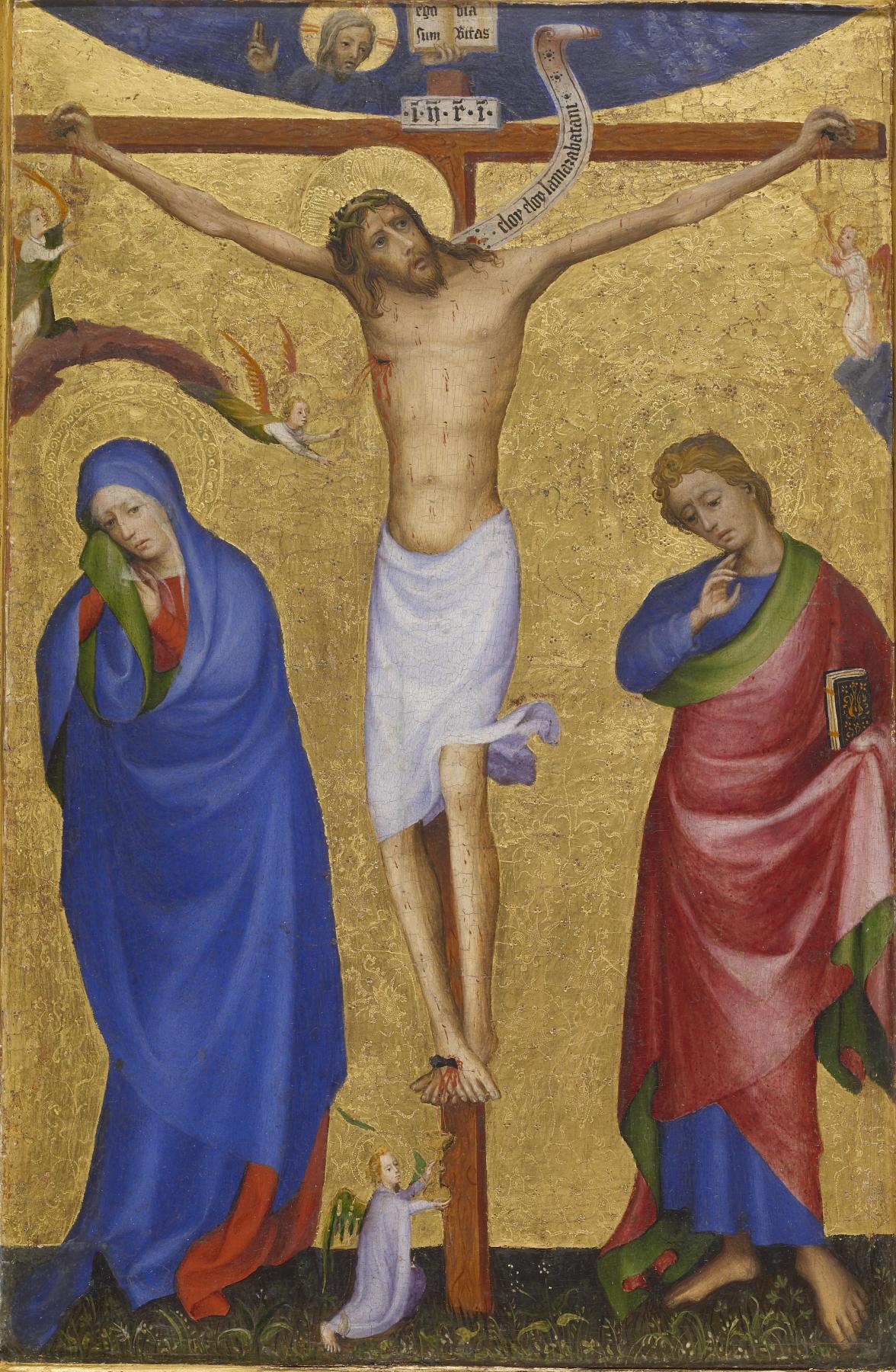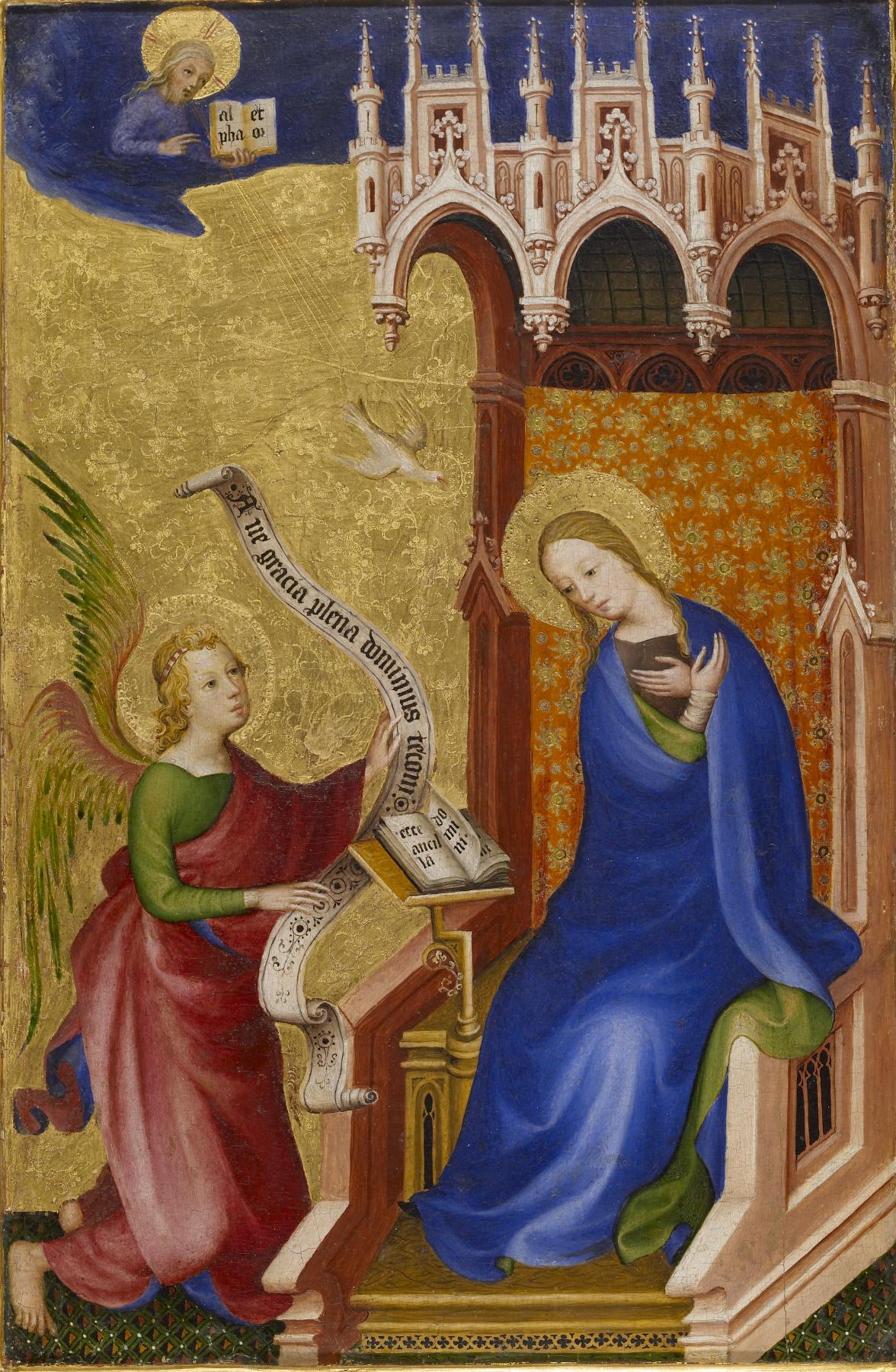Two Panels depicting the Annunciation, Baptism of Christ and Crucifixion from the Antwerp-Baltimore Quadriptych
(Renaissance Europe )
This extremely important masterpiece is one of the earliest paintings of the Netherlandish school. The style suggests that the artist came from Guelders, in the northern Netherlands, as did the famous Limbourg brothers, who settled in Paris. The overall theme of the six scenes--Annunciation, Nativity, Crucifixion, Resurrection, Baptism, Saint Christopher--is the divinity of Christ and the certainty of salvation. It is one of the earliest works where we find evidence of oil paint, a medium that, through its translucency, helps to bring out the richness and vibrancy of details from nature, such as the fish swimming in the Jordan River. The realism for which 15th-century Northern European painting is known is evident in the close attention paid to describing nature with such detail. This Baptism scene is an outer wing of a small, folding altarpiece of which one half (including the Annunciation and Calvary) belongs to the Walters and the other (the Nativity, Resurrection, Saint Christopher) to the Museum Meyer van den Bergh, Antwerp. The altarpiece can be traced back to the Carthusian monastery of Champmol near Dijon, France, founded by Philip the Bold (1342-1404), Duke of Burgundy, and surely was made for Philip to take on his travels.
Provenance
Provenance (from the French provenir, 'to come from/forth') is the chronology of the ownership, custody, or location of a historical object. Learn more about provenance at the Walters.
The Chartreuse de Champmol, until 1772-1774 (?); Louis XV, King of France, Paris and Versailles [date of acquisition unknown], by purchase; Cardinal Charles Antoine de la Roche-Aymon, Château de Champigny-les-Vitraux [date of acquisition unknown], by purchase; Charles Guillaume de la Roche-Aymon (d. 1851) [date of acquisition unknown], by inheritance; Cuvillier, Niort, Deux Sèvres, prior to 1904, by purchase; Arnold Seligmann, Rey and Co., Paris [date of acquisition unknown], by purchase; Henry Walters, New York, 1919, by purchase; Sadie Jones (Mrs. Henry Walters), New York, 1931, by inheritence; Sale, New York, 1939; Walters Art Museum, 1939, by purchase.
Exhibitions
| 2012-2013 | The Road to Van Eyck. Museum Boijmans Van Beuningen, Rotterdam. |
| 2004-2005 | Art from the Court of Burgundy, 1364-1419. Musée des Beaux-Arts de Dijon, Dijon; The Cleveland Museum of Art, Cleveland. |
| 1998-2001 | Highlights from the Collection. The Walters Art Gallery, Baltimore. |
| 1997 | Van Eyck's Annunciation: The Meeting of Heaven and Earth. The Art Institute of Chicago, Chicago. |
| 1994-1995 | The Art of Devotion in the Late Middle Ages in Europe, 1300-1500. Rijksmuseum Amsterdam, Amsterdam. |
| 1962 | The International Style: The Arts in Europe Around 1400. The Walters Art Gallery, Baltimore. |
Conservation
| Date | Description | Narrative |
|---|---|---|
| 1/15/1940 | Treatment | re-housed; mounted |
| 2/25/1960 | Treatment | loss compensation; coated |
| 1/1/1961 | Examination | examined for condition |
| 1/17/1961 | Examination | examined for exhibition |
| 1/17/1961 | Examination | examined for condition |
| 10/11/1963 | Treatment | loss compensation |
| 11/12/1964 | Examination | examined for condition |
| 1/1/1993 | Examination | examined for loan |
| 1/12/1993 | Loan Consideration | examined for loan |
| 3/19/1997 | Loan Consideration | examined for loan |
| 6/20/1997 | Examination | examined for condition |
| 5/19/2004 | Loan Consideration | examined for loan |
Geographies
France, Dijon (Place of Origin)
Measurements
Annunciation/Baptism panel framed H: 14 5/8 x W: 10 7/16 x D: 13/16 in. (37.2 x 26.5 x 2 cm); Annunciation image H: 12 11/16 x 8 5/16 in. (32.2 x 21.1 cm); Baptism image H: 12 3/4 x W: 8 5/16 in. (32.4 x 21.1 cm); Crucifixion panel framed H: 14 9/16 x W: 10 1/4 x D: 7/8 in. (37 x 26 x 2.2 cm); Crucifixion image H: 12 11/16 x 8 1/4 in. (32.2 x 21 cm)
Credit Line
Museum purchase [formerly part of the Walters Collection], 1939
Location in Museum
Accession Number
In libraries, galleries, museums, and archives, an accession number is a unique identifier assigned to each object in the collection.
In libraries, galleries, museums, and archives, an accession number is a unique identifier assigned to each object in the collection.
37.1683






